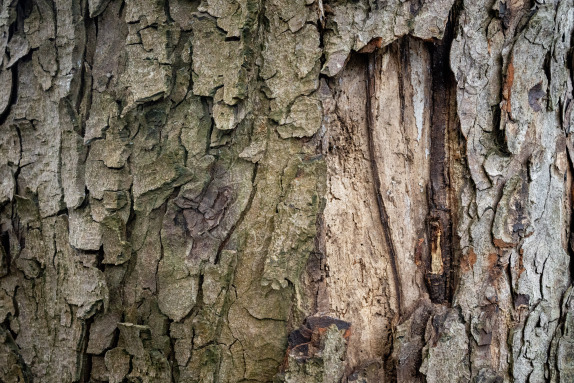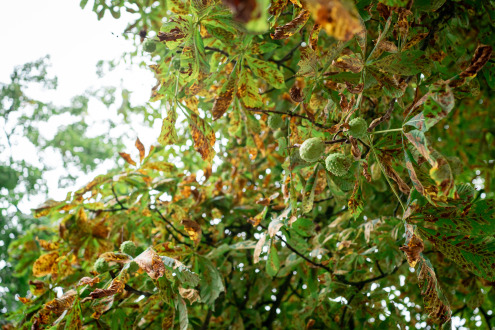Chestnut blight
The horse chestnut, also known as Aesculus hippocastanum, is an imposing deciduous tree that can often be found in parks, avenues and gardens. In Bocholt, the chestnut has also been planted as a street tree in some places. Some specimens, for example on Herzogstraße, are between 40 and 70 years old.
Unfortunately, in recent years the horse chestnut has been suffering from a threatening plant disease known as horse chestnut blight. Horse chestnut blight is a complex health disorder that is caused and favoured by various factors.
Two of the factors are the bacterium "Pseudomonas syringae pv. aesculi" and the butterfly "Cameraria ohridella", also known as the horse chestnut leaf miner. These two pests attack horse chestnut trees in different ways and cause considerable damage. The Pseudomonas bacterium in particular causes long-term problems for the trees: If a tree is infested, the bark is often damaged. This in turn serves as an entry point for fungi, which ultimately weaken the tree over the years and eventually destroy it.
Creeping death of trees
If a tree is infested, black spots initially form on the bark of the trunk. As the disease progresses, clearly recognisable cracks form. "In an advanced stage, visible fungal growth occurs and parts of the crown die off as they are no longer supplied with nutrients and water", says Peter Schlabs from the city's Urban Greenery and Environment division. If the wood rots, branches could fall onto the cycle paths and pavements and road safety is then no longer guaranteed.
What is the city of Bocholt doing?
One thing is clear: the bacterium is probably unstoppable. The city of Bocholt assumes that the majority of horse chestnut trees throughout the city are now infested with the Pseudomonas bacterium. Infested street trees (see also below: Frequently asked questions, When are trees removed?) are identified and monitored by the city as part of regular inspections. If road safety can no longer be guaranteed, trees are felled and replaced.
Frequently asked questions
How many horse chestnuts are there in Bocholt?
The exact number of chestnut trees in the urban area is not known (as of 08/2023), but the administration estimates that there are around 400 to 600 horse chestnuts.
This corresponds to around one to two per cent of the city's tree population.
Are chestnuts also affected by chestnut blight?
The European chestnut (Castanea sativa) is not affected by chestnut blight. Only horse chestnuts are affected. (Soap tree family, genus: horse chestnut).
Despite the similarity in name, sweet chestnut and horse chestnut are not related.
When will the trees be removed?
Urban trees are regularly checked for road safety by trained specialists. The reason is obvious: falling branches or toppling trees can damage buildings or parked cars - or even pose a danger to life and limb. This is why trees are felled and replaced as soon as they are no longer safe for traffic.
Will new chestnuts be planted?
When street trees have to be removed, new trees are planted in their place. The city of Bocholt has refrained from planting horse chestnut trees for several years now.
Depending on the location, different tree species are selected for planting that suit the respective local conditions and are sustainable in view of climatic changes.
For example, Japanese string trees were planted on Herzogstraße in Bocholt to replace the dead chestnut trees.
Are brown leaves in summer a sign of the disease?
The brown leaves of the trees are often caused by the horse chestnut leaf miner (Cameraria ohridella). The adult leaf miner lays its eggs (usually in spring) on the underside of the horse chestnut leaves.
The larvae that hatch from the eggs begin to eat their way into the leaves. In doing so, they follow the natural veins of the leaves, which leads to characteristic, winding tunnels.
As the larvae eat their way through the leaf tissue, they suck the sap from the cells and disrupt the normal transport of water and nutrients in the leaves. These tunnels thus disrupt photosynthesis - the leaves turn brown.
"A healthy chestnut tree can cope with leaf miners alone", says Peter Schlabs. However, infestation by leaf miners is an additional stress factor for trees that are already diseased, says Schlabs.





